By De Clarke
On Saturday March 14th, the monthly Cortes Currents news/talk show featured an interview with Mark Lombard, contract manager for the Cortes Forestry General Partnership. This podcast explores what the “Community Forest” is, and how it works. Did you know that CFGP’s license now covers far more hectares of Cortes Island than the MMB/IT/Mosaic license? This and many other interesting details are discussed in our program (such as what “MMB” and “IT” mean).
A Tradition Of Selective Woodlot Harvesting
Mark Lombard is a “seventh generation logger” from a family with a long tradition of selective woodlot harvesting. He grew up working on family woodlots. In addition to years of hands-on experience, he also has an undergraduate degree in business finance and a graduate degree in environmental policy with a focus on climate change, energy policy, and forest policy — “specifically community forests, and capacity building for community forests.” So the Cortes Community Forest project was a perfect fit. He served on the Board for a few years before stepping down to assume the operations manager role.
In the course of the interview, we talk about what sustainability means; the economics of selective woodlot operation (as opposed to industrial clearcut logging); and how the CFGP (a for-profit corporation) covers its operating costs. “We want to be known for producing high-quality timber,” says Mark. This means investing more heavily in woodlot maintenance and selective harvesting — aging the forest to product higher quality sawlogs, rather than taking immature trees for immediate fibre production. It means that short term profit maximising is not the primary focus, and Mark discusses a more inclusive, community-oriented business model.
On Cortes Island
As Mark explains, the best logs stay on Cortes — and so do the worst. Local mill operators have first dibs on the high-graded logs, and the lowest-quality wood is used to supply the community firewood program. The middle-grade logs mostly go to plywood mills on Vancouver Island and the lower main; only about 15 percent of the timber goes outside the province. About 25 percent of the logs stay on the island to feed local mills. Mark provides a lot of interesting detail about the market for Cortes’ timber.
Mark explains why selling firewood doesn’t make sense. We discuss the economics and logistics of the Community Forest firewood program, and how it has evolved over the years. At present, the “slash” and low-grade logs are offered to the public on a “free use permit” basis. Volunteers load and transport the firewood; in exchange for delivering a truckload of firewood to a senior or other eligible recipient on the island, they get one truckload for themselves. This reduces the wildfire fuel load on the cut area, while helping neighbours who for various reasons are unable to process their own firewood.
Cortes Community Forest & The Province
We discuss the relationship of the Community Forest project and the Province; initially there was concern that the Province would bring pressure to bear on Cortes Island to meet the “AAC” (annual allowable cut, actually more of a target than a limit) that government guidelines would recommend for our hectarage. Mark explains how that pressure has been relieved, and the Province is increasingly willing to respect the local process.
Potential For Income Generating Activity
Mark is optimistic about the potential for income-generating “value added” activity based on our managed woodlots. There is, he says, a big market for sustainably sourced lumber, especially finished or semi-finished product like T&G panelling and flooring. “The sky’s the limit,” he says; there is more demand for Community Forest wood than we can supply, and if Cortes islanders want to build a flooring mill or other value-added processing facilities, he believes there is realistic opportunity here. The Community Forest can contribute significantly to building more stable base for our island economy than seasonal tourism — it can support more livelihood than its current modest demand for planters and woodlot workers. Mark invites listeners to contact him for more information.
We wrap up the show with Mark’s sincere gratitude to many people who worked long and hard (from the Eco-Forestry days onward) to bring this project to its present level. He says it’s the best Board he’s ever been involved with, and an historically significant project of cooperation between First Nations and non-native Cortes Islanders. He deeply appreciates the generosity of Klahoose First Nation in inviting non-native islanders to enter into a “50/50” partnership in the Community Forest endeavour.




